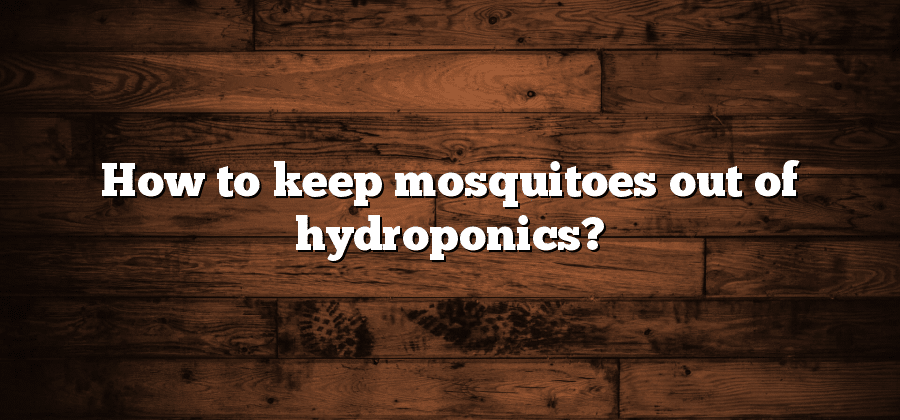Identifying the Mosquito Problem in Hydroponics
One of the challenges faced by hydroponic growers is the presence of mosquitoes in their systems. These tiny, flying insects can not only be a nuisance but also pose a risk to the overall health of the plants. Identifying the mosquito problem in hydroponics is crucial in order to take the necessary measures to control their population and ensure the success of your hydroponic crop.
The first step in identifying the mosquito problem in hydroponics is to closely monitor your system. Keep an eye out for adult mosquitoes hovering around your plants or resting on the walls of the growing area. Additionally, check for larvae or pupae in standing water or on the surface of your nutrient solution. These larvae and pupae are often found in dark, hidden corners of the hydroponic system, such as in grow trays or reservoirs. By regularly inspecting your system, you can quickly spot the presence of mosquitoes and take action before they become a larger issue.
Understanding the Life Cycle of Mosquitoes
Mosquitoes are a common nuisance in hydroponic systems, posing risks to both plants and cultivators. To effectively control and prevent mosquito infestations, it is crucial to understand their life cycle. The life cycle of a mosquito consists of four stages: egg, larva, pupa, and adult.
The first stage, the egg, is usually laid in standing water or areas prone to flooding. Female mosquitoes typically lay their eggs in small clusters or as individual eggs that float on the water’s surface. These eggs are incredibly resilient and can survive in drying conditions for several months. Once the eggs come into contact with water again, they hatch, progressing into the larval stage.
Larvae are commonly known as wigglers due to their distinct squirming movements in the water. At this stage, mosquitoes are filter feeders, consuming organic matter and microorganisms present in the water. Larvae breathe through a specialized tube called a siphon located at the back of their bodies, enabling them to come up to the water’s surface to breathe air. After undergoing several molts, the mosquito larvae enter the pupal stage.
Implementing Proper Water Management Practices
Maintaining proper water management practices is essential in preventing mosquito infestations in hydroponic systems. Excess moisture can create a favorable breeding environment for mosquitoes, putting the health of your plants at risk. To mitigate this problem, it is crucial to regularly monitor and manage the water levels in your hydroponic setup.
First and foremost, ensure that your system is equipped with a reliable drainage mechanism. This will help remove any accumulated water in the system, minimizing the chances of mosquito breeding. Additionally, it is vital to maintain a consistent watering schedule. Overwatering can lead to stagnant water, which is an ideal breeding ground for mosquitoes. Regularly assess the moisture levels in the growing medium and adjust the watering frequency accordingly. By implementing proper water management practices, you can create an unfavorable environment for mosquitoes and promote the healthy growth of your hydroponic plants.
Installing Physical Barriers to Prevent Mosquito Entry
The use of physical barriers can be an effective method in preventing mosquitoes from entering the hydroponic system. These barriers act as a physical barrier that restricts the access of mosquitoes into the growing area. One common type of barrier is the use of fine mesh screens or netting. These screens are placed over windows, vents, or any other openings that mosquitoes may use to enter the facility. By blocking their entry, the risk of mosquito infestation is significantly reduced.
Another option for physical barriers is the use of door sweeps or weather stripping. These are installed on doors and any other openings that may have gaps or spaces where mosquitoes can enter. These barriers create a tight seal, preventing mosquitoes from finding their way inside the hydroponic system. By implementing these physical barriers, growers can ensure that their plants are protected from the potential harm caused by mosquito infestation.
Using Natural Mosquito Repellents in the Hydroponic System
Natural mosquito repellents can be effective in controlling mosquito populations in hydroponic systems. These repellents are derived from natural ingredients such as essential oils, herbs, and plant extracts, making them safer and more environmentally friendly compared to chemical alternatives. These repellents work by emitting scents that repel mosquitoes, thus preventing them from entering the hydroponic system and laying their eggs in the nutrient solution.
One popular natural mosquito repellent for hydroponic systems is citronella oil. Citronella is derived from a type of grass and has been used for centuries to repel mosquitoes. When used in the hydroponic system, it can be applied as a spray or added directly to the nutrient solution. Other natural repellents that can be used include lemongrass, lavender, and peppermint oil. These repellents not only deter mosquitoes but also add a pleasant aroma to the hydroponic system. By incorporating natural mosquito repellents into the hydroponic system, growers can minimize the risk of mosquito infestation and ensure the health and productivity of their plants.






